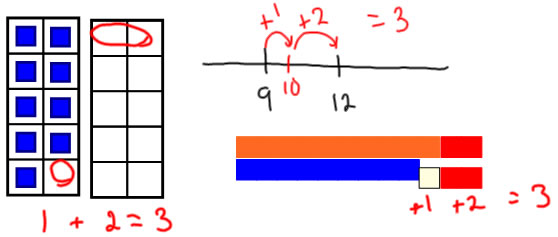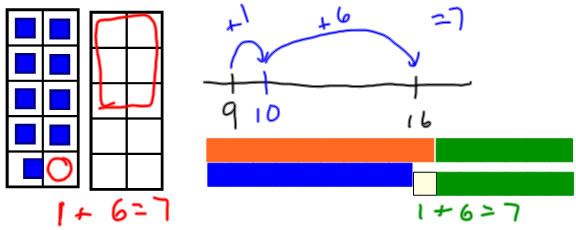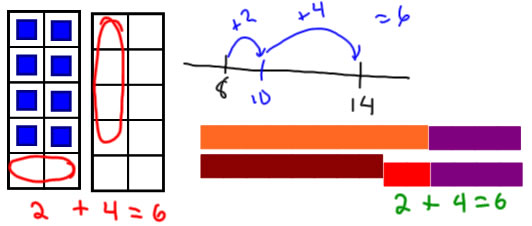Basic Facts Lesson 2.10: Build up through ten to subtract
Building up through ten or adding up using ten to subtract is one of the more important subtraction strategies, because it helps us solve a lot of problems that are otherwise rather tricky.
The first idea children need to use this strategy is to understand the part-whole model for subtraction. Consider the example of 12-9. there are three different ways we can think of what 12-9 means.
We can think of it using a part-whole model for subtraction: 12 is a whole made of two parts: 9 and an unknown amount. I can find the missing part by thinking how many more than 9 do I need to get 12? Nine and 12 are close enough, that I can count on to find this answer pretty quickly: 9...10, 11, 12. I need 3 more to get to 12, so the missing part is 3.
We can think of it using a take-away (SRU) model of subtraction: I have 12 and I take 9 away. Now 9 is a pretty big number--it's almost as big as 12, so taking away 9 one by one (by, for example, counting back 9) would be pretty inefficient, so that's probably not going to be the best way to think about it for solving this particular problem (or any problem where you are taking away 9).
We can think of it using a compare model for subtraction: how much bigger is 12 than 9. In practice, how you solve this (if you don't have to count out 9 and 12 cubes first to do it) is very similar to how you would solve in the part-whole model, so we won't think of this as a separate way to solve right now. |
 |
Building up through ten uses part-whole thinking, and it's rather similar to counting on to from 9 to 12. Instead of counting on, though, we add on in parts: we add enough to get to 10: 9+1=10; then we add enough more to get to the whole: 10+2=12.
Some good ways of seeing this are to use representations that emphasize 10. My examples here are ten frames, open number lines and Cuisenaire rods.
In each case, the first step is to get from the part (9) up to 10 (9+1=10).
The next step is to get from 10 up to the whole (10+2=12).
Then we put together the parts we used to get from the part to the whole (1+2) to find the missing part (3).
If we were just using numbers we would write:
9+1=10
10+2=12
1+2=3
so 12-9=3
|
 |
The really nice thing about this strategy is that it works well with larger wholes: 16-9 isn't much more difficult than 12-9.
9+1=10
10+6=16
1+6=7
so 16-9=7
|
 |
Subtracting 8 works well with this strategy too, because 8 is also close to 10.
8+2=10
10+4=14
2+4=6
so 14-8=6 |
 |
Notice, when I represent the strategy just with number sentences I use one number sentence for each idea:
Add up from the part to 10
Add up from 10 to the whole
Add the two parts that you added on
Say the answer
There are two different phrases I use to describe this strategy. This is an "Adding Up To" strategy, because we are getting from the part to the whole by adding on to the 9. This is also a strategy where we "Bridge With 10" because our stopping off point between the part and whole is 10.
The things children need to know and be able to do to be able to use this strategy are:
- understanding subtraction in terms of parts and wholes so that they know that you can find an answer to a subtraction problem (a missing part) by asking how much more do you need to get from the part to the whole? (This is the biggest conceptual hurdle in this strategy).
- knowing partner numbers that make 10--at least and especially knowing that 9+1=10 and 8+2=10.
- knowing the base 10 structure of the teen numbers (11=10+1; 12=10+2; 13=10+3, etc)
Once children can use this strategy, it becomes an efficient way of solving rather a lot of subtraction problems, and it could be used to solve still more, though it isn't an efficient strategy for most children for those other facts:
| Efficient (minuend >10, subtrahend = 8 or 9) |
Do-able, but not efficient (minuend >10, subtrahend <8) |
18 - 9
17 - 9
16 - 9
15 - 9
14 - 9
13 - 9
12 - 9
11 - 9
|
17 - 8
16 - 8
15 - 8
14 - 8
13 - 8
12 - 8
11 - 8
|
|
16 - 7
15 - 7
14 - 7
13 - 7
12 - 7
11 - 7
|
15 - 6
14 - 6
13 - 6
12 - 6
11 - 6
|
14 - 5
13 - 5
12 - 5
11 - 5
12 - 3
11 - 3
|
13 - 4
12 - 4
11 - 4
11 - 2
|
|



